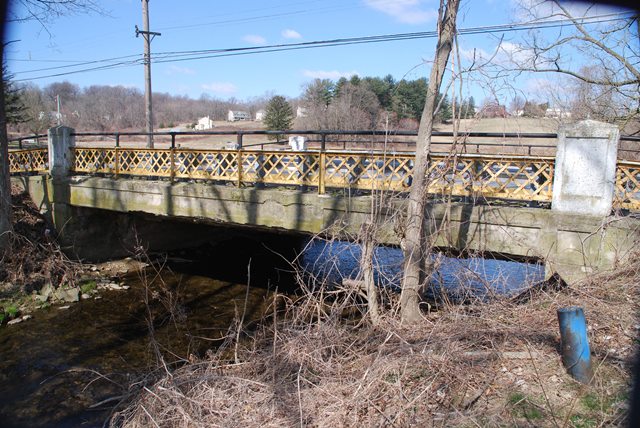We Recommend:
Bach Steel - Experts at historic truss bridge restoration.
BridgeHunter.com Phase 1 is released to the public! - Visit Now
State Street Bridge

Primary Photographer(s): Elaine Deutsch
Bridge Documented: March 29, 2013
Avondale: Chester County, Pennsylvania: United States
Not Available or Not Applicable
35.0 Feet (10.7 Meters)
37.0 Feet (11.3 Meters)
23 Feet (7.01 Meters)
1 Main Span(s)
15740202600001

View Information About HSR Ratings
Bridge Documentation
This bridge no longer exists!
Bridge Status: Demolished and replaced.View Archived National Bridge Inventory Report - Has Additional Details and Evaluation
This bridge is a steel stringer with concrete encased beams. Concrete encased steel stringer bridges are less common than those without concrete encasement. While the Historic Bridge Inventory would have you believe that stringer bridges with lattice railings are common, this is not really the case in Pennsylvania. This bridge's railings are thus unusual among steel stringer bridges. The railings are also unusual because the lattice component is combined with a pipe on top, and also concrete posts.
Information and Findings From Pennsylvania's Historic Bridge InventoryDiscussion of Bridge The single span, 37'-long encased steel stringer bridge built in 1921 is supported on concrete abutments with wingwalls. The bridge is finished with metal lattice railings with paneled concrete posts. Luminaires have been lost and the posts capped with cement. The stringer encasement has a paneled fascia. Concrete encasement is spalling from the bottom flanges of the beams. Concrete encasement was favored in the state because it provided protection for the steel and eliminated the need to periodically paint the beams. Encased steel stringer bridges from before 1910 are not uncommon, and this later 1921 example has no distinguishing features. Decorative lattice railings are not noteworthy and are found with all types of bridges from the 1890s through the 1930s. An undistinguished example of one of the most common, mid-20th century bridge types and designs in the state, it is one of over 630 Discussion of Surrounding Area The bridge carries a 2 lane road and 2 sidewalks over a stream on the west side of Avondale. Northwest of the bridge is an open field, and at the southwest quadrant are a forested lot and a late-20th-century residence. At the bridge's southeast quadrant is a modern water pumping station. At the northeast quadrant are a row of four late-19th to early 20th century vernacular frame dwellings with replacement siding, porch posts, and fenestration. The setting does not appear to have the architectural integrity or cohesiveness of resources to merit historic district potential. Bridge Considered Historic By Survey: No |
![]()
Photo Galleries and Videos: State Street Bridge
Bridge Photo-Documentation
Original / Full Size PhotosA collection of overview and detail photos. This gallery offers photos in the highest available resolution and file size in a touch-friendly popup viewer.
Alternatively, Browse Without Using Viewer
![]()
Bridge Photo-Documentation
Mobile Optimized PhotosA collection of overview and detail photos. This gallery features data-friendly, fast-loading photos in a touch-friendly popup viewer.
Alternatively, Browse Without Using Viewer
![]()
Maps and Links: State Street Bridge
This historic bridge has been demolished. This map is shown for reference purposes only.
Coordinates (Latitude, Longitude):
Search For Additional Bridge Listings:
Bridgehunter.com: View listed bridges within 0.5 miles (0.8 kilometers) of this bridge.
Bridgehunter.com: View listed bridges within 10 miles (16 kilometers) of this bridge.
Additional Maps:
Google Streetview (If Available)
GeoHack (Additional Links and Coordinates)
Apple Maps (Via DuckDuckGo Search)
Apple Maps (Apple devices only)
Android: Open Location In Your Map or GPS App
Flickr Gallery (Find Nearby Photos)
Wikimedia Commons (Find Nearby Photos)
Directions Via Sygic For Android
Directions Via Sygic For iOS and Android Dolphin Browser
USGS National Map (United States Only)
Historical USGS Topo Maps (United States Only)
Historic Aerials (United States Only)
CalTopo Maps (United States Only)

